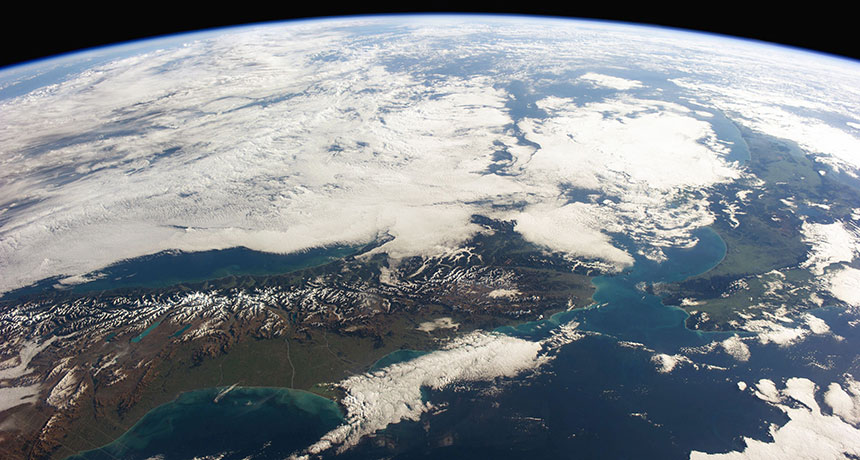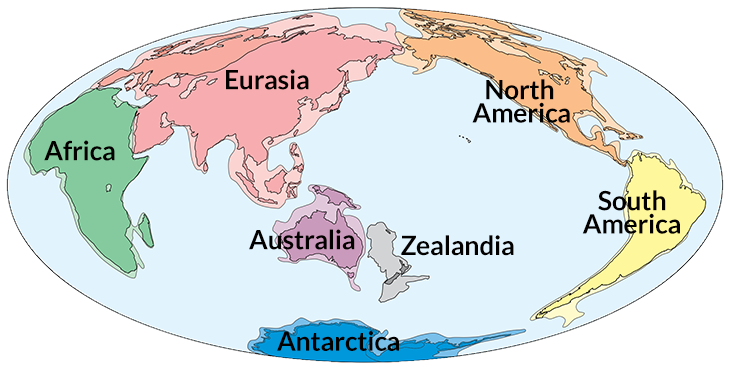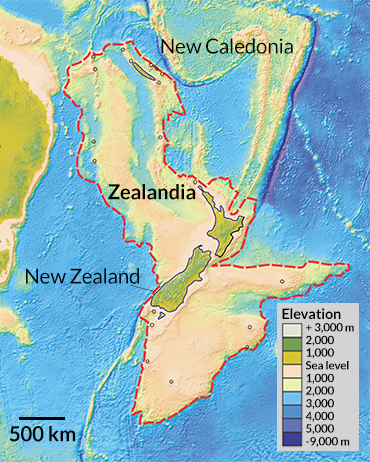
LOST LAND New Zealand rises from the center of a largely submerged continent called Zealandia, scientists propose.
Stuart Rankin/Flickr (CC BY-NC 2.0), NASA
- More than 2 years ago
Lurking beneath New Zealand is a long-hidden continent called Zealandia, geologists say. But since nobody is in charge of officially designating a new continent, individual scientists will ultimately have to judge for themselves.
A team of geologists pitches the scientific case for the new continent in the March/April issue of GSA Today, arguing that Zealandia is a continuous expanse of continental crust covering around 4.9 million square kilometers. That’s about the size of the Indian subcontinent. Unlike the other mostly dry continents, around 94 percent of Zealandia hides beneath the ocean. Only New Zealand, New Caledonia and a few small islands peek above the waves.
“If we could pull the plug on the world’s oceans, it would be quite clear that Zealandia stands out about 3,000 meters above the surrounding ocean crust,” says study coauthor Nick Mortimer, a geologist at GNS Science in Dunedin, New Zealand. “If it wasn’t for the ocean level, long ago we’d have recognized Zealandia for what it was — a continent.”
The landmass faces an uphill battle for continent status, though. Unlike planets and slices of geologic time (SN: 10/15/16, p. 14), no international panel exists to officially rubber-stamp a new continent. The current number of continents is already vague — usually given as six or seven, with geologists referring to Europe and Asia collectively as Eurasia. Proponents will just have to start using the term “Zealandia” and hope it catches on, Mortimer says.
Story continues below image
New world order

A landmass called Zealandia (gray region) deserves to join the ranks of continents, geologists propose. While only 6 percent of Zealandia rises above sea level (dark gray), including New Zealand, swaths of other continents are also submerged along their margins (light-shaded regions).
This odd path forward stems from the simple fact that nobody expected another addition to the continental ranks, says Keith Klepeis, a structural geologist at the University of Vermont in Burlington who supports Zealandia’s inclusion. The discovery illustrates that “the large and obvious can be overlooked in science,” he says.
Mortimer and others have been building a case for Zealandia for more than a decade and say they’ve now ticked off the boxes required to meet common definitions of a continent. The region is composed of continental rocks such as granite, for instance, unlike the denser volcanic basalt that forms ocean crust. Zealandia is also spatially distinct from nearby Australia thanks to an intervening stretch of ocean crust.
“If Zealandia was physically attached to Australia, then the big news story here wouldn’t be that there’s a new continent on planet Earth; it’d be that the Australian continent is 4.9 million square kilometers larger,” Mortimer says. Other geologic features rising from the seafloor either are not made of continental crust, such as volcano-built submarine plateaus, or are not distinct from nearby continents, such as Greenland.
Size is a sticking point, though. No minimum size requirement exists for continents. Mortimer and colleagues propose a 1-million-square-kilometer cutoff point. If this limit is accepted, Zealandia would be the scrawniest continent by far, little more than three-fifths the size of Australia. (Both submerged and dry areas contribute to a continent’s overall size.)

“Zealandia’s in this sort of gray zone,” says Richard Ernst, a geologist at Carleton University in Ottawa. He proposes that an intermediate term could help bridge the gap between microcontinent and full-blown continent: mini-continent. The definition would cover Zealandia as well as other not-quite-continents such as India before it plowed into Eurasia tens of millions of years ago. Such a solution would be similar to the route taken for Pluto, which was demoted from planet to the newly coined “dwarf planet” in 2006.
Scientists previously assumed that New Zealand and its neighbors were an assortment of islands, fragments of long-gone continents and other geologic odds and ends. Recognizing Zealandia as a coherent continent would help scientists piece together ancient supercontinents and study how geologic forces reshape landmasses over time, Mortimer says.
Zealandia probably began as part of the southeastern edge of the supercontinent Gondwana, making up about 5 percent of that supersized landmass, before it began peeling off around 100 million years ago. This breakup stretched, thinned and distorted Zealandia, which ultimately lowered the region below sea level.






